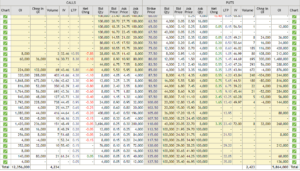The Internet is stuffed with resources. You’ll find tons of data out there free of charge. However, as the count increases, it’s actually inconceivable to remember all of the websites that you simply visit even in a single day.
However, when the subject comes to acquiring the related info and the maximum information and all the related data, one always wish to persist with his favorite websites where he may get all the quality information.
Stock market investing is a risky venture. It’s worthwhile to be very cautious whereas putting your hard-earned money into it. Before diving into the dynamic stock market, you must possess the best set of information and sufficient information. So, as an investor, you should be aware of a few of the finest websites for Indian stock market analysis.
All have their own favorites! However, in terms of selecting the most effective websites for Indian stock market research, we would have a standard selection. Let’s see if our choice matches together with your short term and long term investing objectives.
1. MONEYCONTROL
Website: www.moneycontrol.com
The website was started by the husband and wife team of Victor and Sangeeta Fernandes. In 2000, it was acquired by E-Eighteen dot com, a subsidiary of the Indian TV channel TV18. The couple were given 7.5% of the equity capital and E-18 got 92.5% following the acquisition. In 2014, Reliance Industries acquired Network 18 and TV18. This acquisition included Moneycontrol.com and several other websites and channels owned by TV18.
Moneycontrol is definitely the preferred website among the many Indian stock investor. You’ll find all types of information on this website like market news, trends, charts, livestock prices, commodities, currencies, mutual funds, personal finance, IPOs and many others.
That is certainly one of many extremely standard stock market website for an Indian investor. In different words, it may be considered probably the most accessed website, each by potential and present stock investors.
You even have a platform to track your investments and create a wish list too. Furthermore, Money Control mobile app is much more handy to put in and use. So, an entire bundle for a stock investor, whether a beginner or a professional.
It gives numerous stock securities info like their Sensex and Nifty value. Stock securities include Equities, debts, Latest IPOs, currencies, live stocks, commodities, and derivatives. Historic knowledge and present efficiency of the various companies can also find right here.
Forums are also facilitated for doing discussions in the group. You’ll be able to refer to those boards and may update yourself with the updated information.
2. NSE INDIA
Website: www.nseindia.com
The National Stock Exchange of India Limited (NSE) is the leading stock exchange of India, situated in Mumbai. The NSE was established in 1992 as the primary demutualized electronic trade within the nation. NSE was the primary exchange within the nation to offer a modern, totally automated screen-based electronic trading system which provided simple trading facility to the traders spread throughout the length and breadth of the country. Vikram Limaye is Managing Director & Chief Executive Officer of NSE.
It has a complete market capitalization of greater than US$2.27 trillion, making it the world’s 11th-largest stock exchange as of April 2018. NSE’s flagship index, the NIFTY 50, the 50 stock index is used extensively by investors in India and all over the world as a barometer of the Indian capital markets. Nifty 50 index was launched in 1996 by the NSE. Nevertheless, Vaidyanathan (2016) estimates that solely about 4% of the Indian economic system / GDP is definitely derived from the stock exchanges in India.
In contrast to countries like America where nearly 70% of the GDP is derived from bigger companies and the corporate sector, the corporate sector in India accounts for only 12-14% of the nationwide GDP (as of October 2016). Of these solely 7,800 corporations are listed of which solely 4000 commerce on the inventory exchanges at BSE and NSE. Therefore the stocks trading on the BSE and NSE account for under round 4% of the Indian economic system, which derives most of its earnings associated exercise from the so-called unorganized sector and households.
As the company has an obligation to submit their financial reviews to the NSE, therefore you may always find the financial information of any firm right here, in case you may find it elsewhere. You’ll find details about the corporates, domestic and foreign buyers, new listings, IPO and many others. NSE India also offers programs and certifications.
It ranks effectively within the prime stock research websites in India. You get to see tons of historic information relating to NSE and Nifty as effectively. You additionally take pleasure in free technical analysis of Indian stocks, reports, charts and different website tools.
3. BSE INDIA
Website: www.bseindia.com
The Bombay stock exchange was founded by Premchand Roychand. He was probably the most influential businessmen in 19th-century Bombay. A person who made a fortune within the stockbroking business and got here to be often known as the Cotton King, the Bullion King or simply the Big Bull. He was also the founding father of the Native Share and Stock Brokers Affiliation, an institution that’s now referred to as the BSE.
Whereas BSE Ltd is now synonymous with Dalal Street, it was not all the time so. The first venue of the earliest stock broker meetings within the 1850s was in relatively pure environs – beneath banyan trees – in entrance of the Town Hall, the place Horniman Circle is now located. A decade later, the brokers moved their venue to a different set of foliage, this time under banyan trees at the junction of Meadows Street and what’s now referred to as Mahatma Gandhi Road. The group ultimately moved to Dalal Street in 1874 and have become an official group referred to as “The Native Share & Stock Brokers Association” in 1875.
On August 31, 1957, the BSE grew to become the primary stock exchange to be acknowledged by the Indian Government under the Securities Contracts Regulation Act. Historically an open outcry flooring trading exchange, the Bombay Stock Exchange switched to an electronic trading system developed by CMC Ltd. in 1995. It took the exchange solely 50 days to make this transition. The BSE has also launched a centralized exchange-based internet trading system, BSEWEBx.co.in to allow traders wherever on the planet to trade on the BSE platform.
The BSE can also be a Partner Exchange of the United Nations Sustainable Stock Exchange initiative, becoming a member of in September 2012.
BSE established India INX on 30 December 2016. India INX is the first international exchange of India.
That is much like NSE India. Nevertheless, you will discover extra historic information right here as BSE Sensex has been included for an extended time in comparison with NSE Nifty.
As well as, over 5,500 companies are listed on BSE whose company actions and financial information could be found on this website. You may also obtain the whole checklist of ‘public’ companies from this website.
4. INVESTING.COM
Website: www.investing.com
Investing.com is a global financial portal and internet brand owned by Fusion Media Limited, registered in the British Virgin Islands, composed of 28 editions in 21 languages and mobile apps for Android and iOS that provide news, analysis, streaming quotes and charts, technical data and financial tools about the global financial markets. The editions each cover a broad variety of financial vehicles including Stocks, Bonds, Commodities, Currencies, Interest Rates, Futures and Options
Branded initially as Forexpros.com, the portal launched in 2007 with editions in four languages: English, Spanish, Hebrew and Arabic, offering free data, information, analysis, news and tools over the Forex market for traders. Six additional editions followed in 2008, growing to a total of 18 different localized editions by the end of 2011.
Investing.com currently offers 30 localized (Language localisation) editions in 22 languages including: Arabic, Chinese, Dutch, English, Finnish, French, German, Greek, Hebrew, Italian, Indonesian, Japanese, Korean, Malay, Polish, Portuguese, Russian, Spanish, Swedish, Thai, Turkish and Vietnamese. Additional editions are dedicated to the Australian, Brazilian, Canadian, Hong Kong, Indian, Mexican and South African markets.
Investing is a good site if you want to find all the information on the same website simultaneously. You can do both fundamental and technical analysis of stocks on this website. The different options available on this website are general info, chart, news and analysis, financials, technicals, forum etc.
Its wide range of tools and comprehensive data can surely incline any investor towards it. Stock screener, Fed rate monitor tool and currency converter are the biggest attractions. The live and interactive charts, stocks charts, indices and forex charts further add to its advantages.
Investing is just like the best newspaper for stock market India.The screen of the site reproduces every detail information towards you regarding the NAV value of your stocks, the index value, the peer information and many other details which can be simplified by customizing the screen according to your preferences.
5. SCREENER
Website: www.screener.in
Screener, a stock analysis instrument especially meant for equity traders in India. With this, you’ll be able to have entry to long term financials of various companies and additional simplify it. Thereby, turning lengthy knowledge into small helpful chunks by customised studies. So, you’ll be able to simply make your self acquainted with helpful financial info of an organization.
Furthermore, with the assistance of it’s screening instrument, you’ll be able to design your personalised display screen and get computerized alerts to trace outcomes. A mixture of a “Firm evaluation” and a “screening” instrument, this absolutely attracts readers to navigate by it.
It is among the greatest Indian stock market technical evaluation web site. It serves you normal details about the market financial system, the corporate efficiency previously and the current, their friends out there and their efficiency too, the corporate’s revenue and losses and the balance sheet, analysis studies and numerous evaluation instruments just like the charts are provided on this platform.
The sophisticated lengthy knowledge might be personalised and customised as per your selection and choice which is able to simplify the understanding.It additionally supplies display screen alerts on the person’s mobile and the websites additionally for each up to date info in the market.












